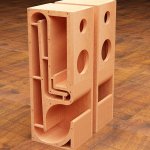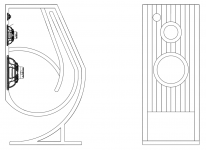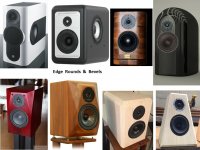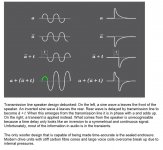Im looking into my next project, a set of desktop speakers with some punch.
I like the build method used on transmission line speakers and I got an available CNC.
Can anyone elaborate on why most all transmission line speakers I find online is 1 way? and wont a 2 way speaker have to ability to play louder without distortions, and both being equally good builds the 2 way will sound better?
If I rip of the design for a transmission line speakers I find online, can I simply scale the enclosure up and down in size (internally) based on the speaker size I want to put in or do I have to do the math on this?
Attached there is a picture of the approx. design im going for, and a sketch i was playing around with.
I like the build method used on transmission line speakers and I got an available CNC.
Can anyone elaborate on why most all transmission line speakers I find online is 1 way? and wont a 2 way speaker have to ability to play louder without distortions, and both being equally good builds the 2 way will sound better?
If I rip of the design for a transmission line speakers I find online, can I simply scale the enclosure up and down in size (internally) based on the speaker size I want to put in or do I have to do the math on this?
Attached there is a picture of the approx. design im going for, and a sketch i was playing around with.
Attachments
Maybe because one of the traditional ways of looking at transmission lines was as a way to extend the bass as low as you wanted. Combine this with the idea that full range design includes working to widen the bandwidth.on why most all transmission line speakers I find online is 1 way?
Modern thinking is a little different, and regardless, yes you can do a multi-way.
In the past 20 years the maths has improved greatly. No longer do we have to use hit and miss rules of thumb. The likes of Augspurger and those who followed.can I simply scale the enclosure up and down in size (internally) based on the speaker size I want to put in or do I have to do the math on this?
I would avoid a transmission line for close-up listening. The bass port from a T-line is delayed from the driver launch and requires at least a half wavelength(several feet) to combine.
A sealed enclosure is the only woofer design that can be made time-accurate.
WindowsOS and AppleOS and LinuxOS support a basic audio equalizer. Are you familar with the Windows10 audio equalizer? There are a few FREE audio equalizers you can download for extra experiments. You may want to remove the current sound driver and install the newest driver available.
For a 2-way desktop computer speaker, you will get the best sound from a sealed midbass with bass equalization from the computer, and a small face-plate 1" dome tweeter butted against the midbass, and crossed around 1700-1800Hz. Your cabinet design should reduce edge diffraction by either cutting deep edge baffles, or machining large radius quarter round edges.
Next, decide upon your budget.
Next, decide upon cabinet/midbass size: 6" - 6.5" - 7"
Next, decide upon the tone differences between cones: PolyPlastic? Paper? Aluminum?
A sealed enclosure is the only woofer design that can be made time-accurate.
WindowsOS and AppleOS and LinuxOS support a basic audio equalizer. Are you familar with the Windows10 audio equalizer? There are a few FREE audio equalizers you can download for extra experiments. You may want to remove the current sound driver and install the newest driver available.
For a 2-way desktop computer speaker, you will get the best sound from a sealed midbass with bass equalization from the computer, and a small face-plate 1" dome tweeter butted against the midbass, and crossed around 1700-1800Hz. Your cabinet design should reduce edge diffraction by either cutting deep edge baffles, or machining large radius quarter round edges.
Next, decide upon your budget.
Next, decide upon cabinet/midbass size: 6" - 6.5" - 7"
Next, decide upon the tone differences between cones: PolyPlastic? Paper? Aluminum?
Attachments
I agree that the closed box is the rational construction. However, A TLS or other quarter wave pipes could be built just for the fun of trying it out. PMC has short TLS and there are other DIY versions of old.
Im looking into my next project, a set of desktop speakers with some punch.
I like the build method used on transmission line speakers and I got an available CNC.
Translam construction might look pretty but setting aside the fact that it's often wasteful of material, smooth curves are not beneficial for bass lines (in most cases the opposite).
Can anyone elaborate on why most all transmission line speakers I find online is 1 way? and wont a 2 way speaker have to ability to play louder without distortions, and both being equally good builds the 2 way will sound better?
The vast majority of TLs / QW variations are in fact multiway speakers, from the classic Bailey / Radford / IMF lines through Fried, Goodmans, PMC, TDL and B&W just to name a handful of commercial manufacturers who produce[d] at least one multiway TL loudspeaker. IPL are one of the more famous kit manufacturers of TLs in the UK (all multiway). Lots of other examples out there too. They're popular with wideband driver users, but far from being exclusive to them.
If I rip of the design for a transmission line speakers I find online, can I simply scale the enclosure up and down in size (internally) based on the speaker size I want to put in or do I have to do the math on this?
Well, you can scale it, but you won't get good results (except by dint of good fortune). A TL / QW is not exempt from the laws of physics, and if you want quality results, they require as much (more, actually) design effort as, say, a sealed or regular Small type vented box.
Attached there is a picture of the approx. design im going for, and a sketch i was playing around with.
The first piece of advice I'd give is don't go down that route. That configuration has multiple potential issues / pitfalls just as a graphical rendering, and if you don't know what you're doing regarding the physics of QW design, you will likely wind up wasting a lot of time & material (to say nothing of money).
Seeing that picture that LineSource posted, it seems so obvious that I don't understand how I could have overlooked it. Mind Blown.
Might want to look here:
Low-Cost PMC-inspired TL Monitor with DC130A and DC28F
I also think that "debunking" illustration was a piece of Russian disinformation.
Low-Cost PMC-inspired TL Monitor with DC130A and DC28F
I also think that "debunking" illustration was a piece of Russian disinformation.
Clearly the point was made, but is that an error in that illustration? Suggestion attached.
If it comes to that, it ain't just a questionable graphic, but some questionable text from the unspecified source:
'The only woofer design that is capable of being made time-accurate is the sealed enclosure'
Since when have sealed enclosures been a woofer design? And while we're on the subject, that phrase 'capable of' is also of critical [sorry, bad pun] importance, since it's not a universal constant applicable to any and all sealed enclosures. The only ones defined (and with slightly questionable accuracy) as 'transient perfect' are critically damped types with a system Qtc = 0.5: it doesn't apply to anything else. And that then goes pear-shaped in practice when any room effects (which still have some influence even in most applications described as nearfield), unless you account for those in the alignment too. In truth, very few designs are in practice transient perfect, including the majority that people call such or believe to be, and not everybody is bothered anyway, providing it's kept within reasonable limits. There is a reason why vented box variations, QW / TLs etc. are popular. Several, in fact.
Last edited:
I've made a desktop transmission line using the Fostex FE-127E and bass was disappointing. Using some AVI Neutron III now and a lot happier. Tried some Wharfedale Denton 80 and too much bass in the office, not pleasant.
I haven’t read but the 1st post, so excuse me if this has been covered before.
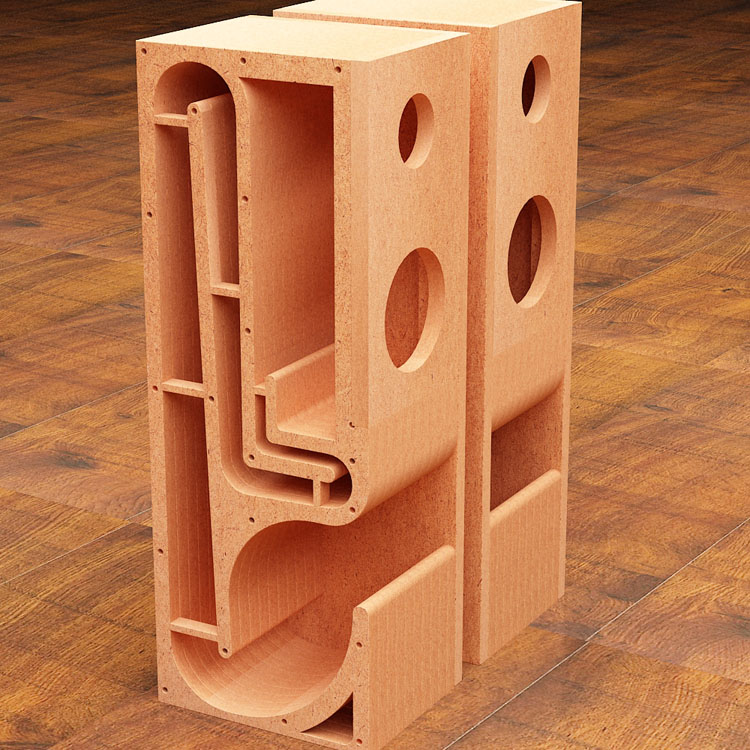
The design above is a really poor attempt at a horn (which is in the same quarter wave family as a more traditional TL). The one below is prettier but still poor for many reasons. Especially if it is desktop size.
And translam is a poor way to build a loudspeaker cabinet and (most often) a huge way of wasting material to just go ahead and use it in the direction it was not intended to be used.
Further, for near-field use, 1-way speakers have a huge advantage in that you do not need to be far enuff away to allow the disparatly placed drivers on the baffle. No issues w multiway TLs (Radford/IMF/Fried/TDL).
A TL cannot be scaled, you need to model it for each specific driver/situation.
A desktop TL is difficult because TLs want to be BIG. Probably the most successful are Scott’s Baby Labs.
More later.
dave
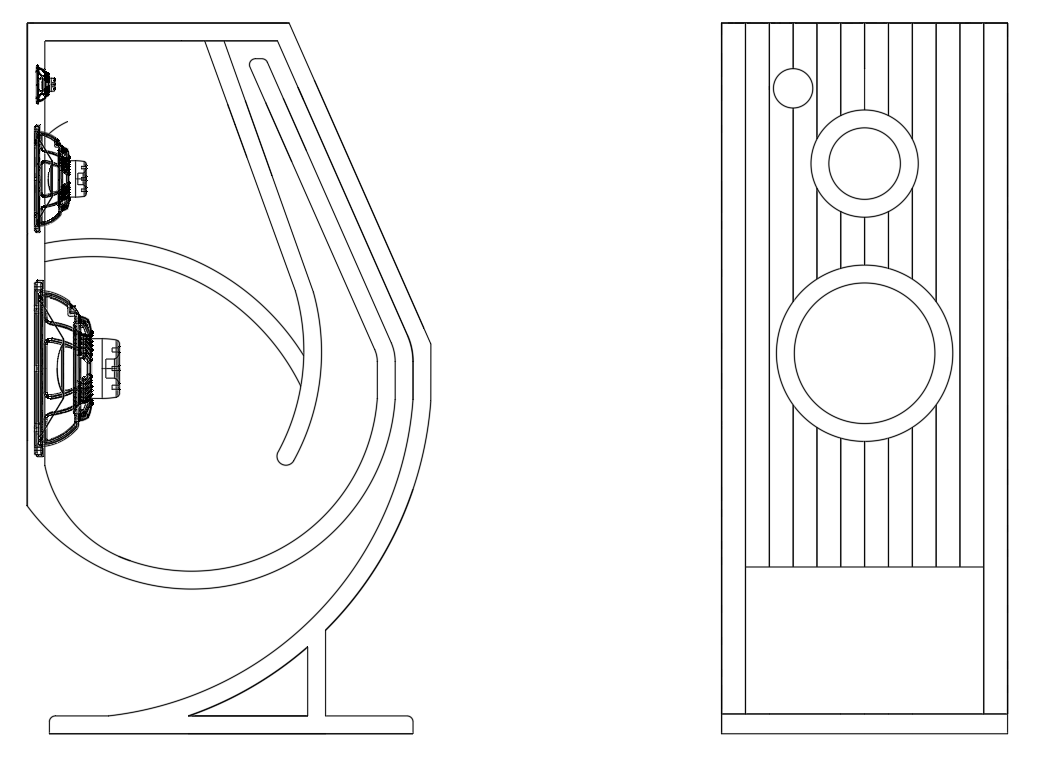
The design above is a really poor attempt at a horn (which is in the same quarter wave family as a more traditional TL). The one below is prettier but still poor for many reasons. Especially if it is desktop size.
And translam is a poor way to build a loudspeaker cabinet and (most often) a huge way of wasting material to just go ahead and use it in the direction it was not intended to be used.
Further, for near-field use, 1-way speakers have a huge advantage in that you do not need to be far enuff away to allow the disparatly placed drivers on the baffle. No issues w multiway TLs (Radford/IMF/Fried/TDL).
A TL cannot be scaled, you need to model it for each specific driver/situation.
A desktop TL is difficult because TLs want to be BIG. Probably the most successful are Scott’s Baby Labs.
More later.
dave
- Home
- Loudspeakers
- Multi-Way
- Transmission line speaker Desktop speakers
